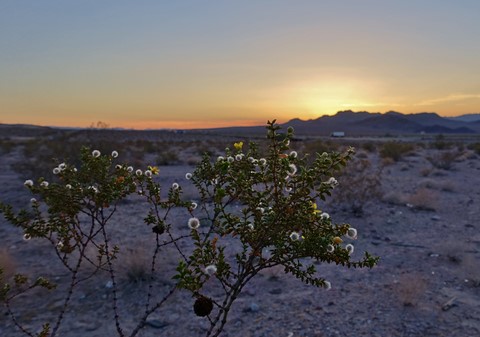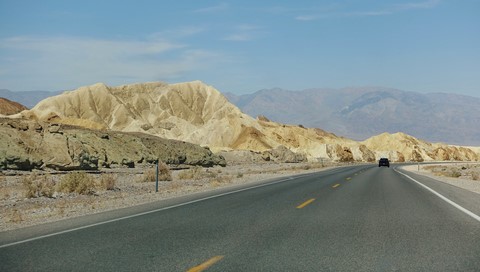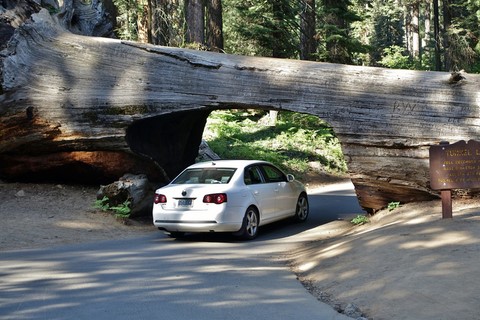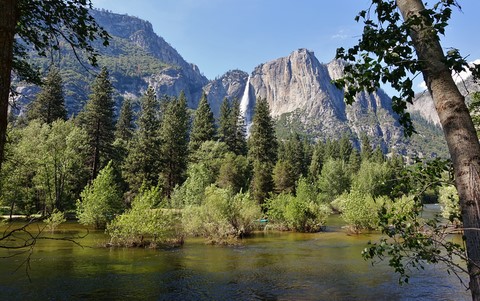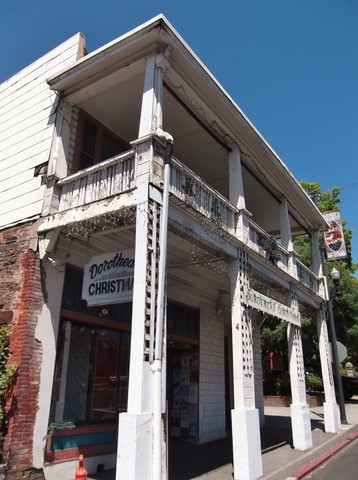Inland California
You can click on pictures to enlarge them
The Mojave Desert
We crossed once again that huge fascinating desert. We even drove on some sections of the mythic Route 66. That time, we were coming from Redondo Beach, headed for Laughlin, Nevada. We made a first stop in Yermo. It is a small village lost in the middle of nowhere along the Interstate 15. Founded in the very early 20th century, it is part of San Bernardino County. We stopped there because we were keen on having lunch at Peggy Sue’s Diner, the famous period diner with its entrance in the shape of a colored jukebox. The owner is none other than the Peggy Sue who gave her name to that famous song from the late Buddy Holly. There they serve dishes and drinks with funny names of actors, movies or cartoons characters, or even titles of rock'n'roll songs. The decoration is lavish: statues (among others in the effigy of Betty Boop or the Blues Brothers), figurines, framed newspaper articles, pictures, vinyl records on the walls, jukebox... All of them refer to the 1950's and the 1960's. The complex also includes a gift shop, and a children's playground in the back.
Then we went to Calico, ghost town cut off from the world. We were the only visitors at that time. It was the end of the afternoon, and the silence was so deep that it was quite absorbing. Built near a silver mine, it thrived especially in the late 19th century before it falls into disuse and gets totally deserted, for the ore had lost value. The various buildings are well preserved or well restored: a town hall, a school, a restaurant, a saloon, a grocery, a leather store, various shops, and even a fire station. The small train that transported silver extracted from the mine is still there. It was absolutely peace and quiet, which allowed us to go back in time and immerse ourselves in a western atmosphere, giving free rein to our imagination or reminiscences of works of the seven art we used to devour during our childhood. We learned later to our great surprise that the place was actually very touristy, or even overrated. Simply, the late time on which we arrived was the reason why the streets of Calico were deserted. Finally, we were lucky. Indeed, in the light of that experience, it will remain in our minds an authentic ghost town that carried us away and made us dream for a short stop-off.
Death Valley National Park
After we visited extraordinary landscapes in Arizona and Utah, we came back to California embarking on a long crossing of Death Valley. Former sea adjacent to the San Andreas Fault on the borders of Nevada, it became an arid area over millenniums, a surreal landscape with its blinding stretches of salt, its sand hills and its canyons on which a range of mountain seems to stand guard. Abandoned borax mines and ghost towns complete the picture made famous by many movies. There we can find the lowest point in Northern America: the wide salt marshes of Badwater Basin, which are 86 meters below sea level.
We took the Death Valley Scenic Byway (California State Route 190), and from the first kilometers, we had the feeling of entering a mysterious and fascinating wasteland. We just had a short stay in Las Vegas, carried away by its crowd, its fervor and its lights that stretch to infinity. The contrast was breathtaking, almost unsettling. But that is the beauty of that kind of trip.
Colors change according to the light and the time of day we cross it. Because you cross Death Valley more than you visit it, at least at that time of year: indeed, the heat is too sweltering, and you do not hold on a long time out of your air-conditioned vehicle. It is definitely a desert, with all that it involves: it is essential to follow strictly written instructions, or instructions provided by the nice rangers if you have the luck to meet them on your way. It is highly recommended to bring plenty of drinking water and to fill up with gas before entering the park. Some gas stations are available there but you will pay more than outside. Food supplies and a first aid kit are welcome as well.
We made a first stop in Zabriskie Point, amazing lunar landscape with tortured shapes and a breathtaking color scheme. Stratum appeared in the rock over the millenniums. Some are inclined at 45°. We had the feeling of visiting an open-air geological museum
Then we stopped at Furnace Creek. The name speaks for itself because it is the place on the planet where the record of the highest temperature was registered (56.7 C°). Nevertheless, we had a picnic there, for it was the first site where we found trees, and therefore some shade. It is in some kind of way the hot spot of Death Valley, the one that has most facilities. A visitor center welcomes you, the only one in the park with that of Scotty’s Castle, more north. There you can also find two hotels, various campsites, two restaurants, a bar, as well as an aerodrome and a golf course. Besides, the presence of the latter in the desert was an aberration according to us, considering the means to be adopted to supply it with water and maintain the green.
We hit the road again and we found ourselves a few kilometers away in a very steep-sided landscape where we were driving on the mountainside. Sensations were exhilarating and breathtaking. And there was still that color scheme… We crossed Towne Pass, Panamint Valley, and Panamint Springs Resort. We had Rainbow Canyon on a side of the road, Darwin Falls on the other side. Finally, we made a last stop at Father Crowley Point, which offered a panoramic view of the above-mentioned Rainbow Canyon and Panamint Valley. It was the end of the afternoon and tints were warmer, covering the dry and rocky landscape with nice colors. We lingered more than in Zabriskie Point for the elevation made the temperature more bearable (or less unbearable)… Then we got in our vehicle to leave the fascinating Death Valley some kilometers further, and head for Bakersfield, our next night stop. Our minds were filled with exhilarating images of extraordinary landscapes, and we figured out crossing that wide park was simply a unique experience.
Sequoia & King’s Canyon National Park
King’s Canyon National Park is in the extension of Sequoia National Park, so both are managed as a single park. They are located respectively on the southern part and the western part of the Sierra Nevada. They offer splendid sites made of granite peaks, very deep gorges and wide forests of sequoias, high trunk trees. The establishment of those parks allowed preserving them.
The canyon that gave its name to King’s Canyon National Park is made of granite, and crossed by King River. The latter also crosses the heart of a valley that makes part of the park, as well as San Joaquin River. But the main attraction is the sequoia General Grant Tree, in the General Grant Grove Forest, that groups together most of the oldest trees: it is more than 80 meters high! The gorges in the park are very abrupt, and Cedar Grove Canyon is the deepest in the country (2400 meters).
In the heart of Sequoia National Park, the aptly named Sequoia Giant Forest groups together the highest sequoias in the world, the absolute record goes to the General Sherman Tree that is about 90 meters high! Taking the time to walk among those majestic giants that exhale pleasant wooden fragrance is an exciting experience. We feel very small in front of the disproportion and the strength that those impressive trunks exude. In the 1930’s, one of them fell on a road and they had to dig in its wood to provide a passage for vehicles (photo). Sensations guaranteed!.. We had also the luck to see a bear from close as soon as we arrived in Crescent Meadows, beautiful clearing with sun-filled verdant meadows, which contrasted with the shade and the relative coolness of the forest. We were able to take the time to contemplate it and take pictures of it while observing a safety distance. Then, we reached Moro Rock, granite dome that offers a panoramic view of a part of the park. To have access there, we had to climb the steps of particularly steep stairways, but it was worth the effort. The park has other main attractions, notably Crystal Cave, sumptuous marble cave with fascinating settings, and Mount Whitney, second highest point in the country (4421 meters high).
Yosemite National Park
It is an extraordinary valley where waterfalls are incredibly high. All around rises huge granite walls; the most remarkable is El Capitan. On the heights, sequoias forests and plateaus of flowered meadows compose landscapes with a wild splendor. The park offers many possibilities for outdoor activities: hiking with many trails offered for hikers of all levels, rafting, kayak, and above all climbing, for the site is one of the most appreciated in the world for that sport. There you can ride a horse, and also a bike on pleasant and well-equipped cycle lanes. It is really huge and we spent two full days there. During our stay, we had the luck to see a young grizzly bear, a brown bear and a coyote.
In the heart of the park, Yosemite Valley - crossed by Merced River in which you can swim - proudly displays the breathtaking steep monoliths of Cathedral Peak, El Capitan and the Half Dome. Waterfalls there are impressive, notably Bridalveil Falls and Yosemite Falls. Those last-mentioned include Lower Yosemite Fall and Upper Yosemite Fall, and are the highest in the park.
We wanted to go to Mariposa Grove to admire its concentration of giant sequoias. Unfortunately, the site was under construction. We fell back on Wawona, place where was the famous «tunnel tree» in the middle of which a road used to run, but it fell on the late 1960’s. However, it is still there and you can go and admire it even though it lost naturally part of its majesty. In front of the Pioneer Yosemite History Center, a suspension bridge spans the river. In the heart of Yosemite Village, near the Visitor Center and the lodge, stands the Ansel Adams Gallery that pays tribute to the famous photograph well known for his pictures of Western America - mainly in black and white – and to his work.
Tuolumne Meadows (photo) is very wild and very vast; it is located nearly 2600 above sea level. The place is very pleasant, the more as we visited in the springtime, totally green. It tempts to soothing and dreamlike. And as it is very wide, there is always a way to move away from floods of tourists. Trees cover it with shade in places, and the river brings additional coolness. Some pontoons give it a special charm. That is the starting-point of some trails in the park. Along the road that leads there, Olmsted Point has a promontory that offers a stunning panoramic view.
You can see the Half Dome from a distance thanks to its so special half-sphere shape. It has become the idealized image of Yosemite. The trail that bears its name is reserved for the most experienced hikers, and it takes between 10 and 12 hours. It ends with stairs carved into the rock. A license in required. The applying is online, and it is advised to book in advance.
We made do with Vernal Fall trail, superb shaded path, one of the most beautiful in the park. Some parts are rather physical. Besides, it is advised to bring a raincoat for the part of the trail which is closest to the fall, where you are abundantly watered by the mist. A viewpoint is located just above the waterfall and allows you to assess its strength and its beauty. If you have the time and the courage, you can carry on until Nevada Fall. Unfortunately, we did not because a sumptuous sunset was waiting for us in Glacier Point. Located almost one kilometer above sea level, that site offers an unrestricted view of Yosemite Falls, and above all the Half Dome. That night, colors were extraordinary. We stayed to admire that breathtaking natural spectacle until nightfall. That moment was magical.
Sonora
Given that dwellings in Yosemite are overpriced, we stayed in that small western town filled with charm a few dozen kilometers west of the park. The road that led us there was very pleasant. We crossed wheat fields and vast orchards, mainly citrus fruits. Old farms with an old-fashioned charm appeared here and there. The landscape was really dry, as much because of the heat wave of that time as due to the drought experienced over long months in California. So, the few lakes that ran along the road - among others Don Pedro Lake - brought their enjoyable share of coolness and humidity. The very late afternoon sun covered the landscape with warm and shimmering colors. We also crossed another charming western village named Groveland.
Founded by Mexican miners during the Gold Rush in California, Sonora quickly fell into disuse once the gold fever was over. Since then, its population has been steadily declining. However, it is very typical and pleasant. Besides, it reminded us Flagstaff in some aspects. The Hispanic influence is naturally very present. We took the time to walk there and admire its wooden façades and its brick façades, as well as its wrought iron balconies that make it look like New Orleans. Small shops, restaurants, bars, saloons and art galleries are numerous there. It exudes a quaint charm and an undeniable authenticity. It has a network of trolleys-buses that look like the cable-cars in San Francisco, and are also very typical. As we were moving away from Washington Street (photo), its main street, we saw small properties and nice little colored houses.
It was really one of the pleasant surprises of our trip.
Published on October, 28th 2017



